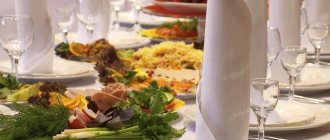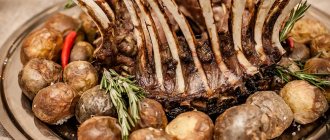The most expensive and lengthy part of a wedding celebration is undoubtedly the banquet. The choice of place for a banquet directly depends on the number of guests, the time of the celebration and the individual wishes of the newlyweds. However, the principle by which tables are filled is approximately the same everywhere. The banquet table should include cold appetizers, salads, fish dishes, hot meat dishes, possibly soup, alcoholic drinks, soft drinks, cake, coffee, tea and fruit.
For one person, the average calculation of drinks and food is approximately the following: cold appetizers, vegetable cuts, fish dishes and salads - 350 g, hot dish (meat and side dish) - 350 g. Alcoholic drinks must be purchased at the following rate: champagne – 0.5 l/1 person, wine – 1 bottle/1 person, vodka – 0.5 l/1 person. Buy non-alcoholic refreshing drinks at the rate of approximately: juice - 0.5 l/1 person, mineral water - 0.5 l/1 person. The optimal menu option for a wedding banquet per person.
Cold appetizers:
- cold smoked fish (sturgeon, halibut, beluga, etc.) - 50-60 g - red salted fish (trout, salmon) - 50-60 g - sandwiches with red caviar - 1-2 pcs - salted herring - 50 -60 g – sliced cheese from smooth cheeses (“Gouda”, “Dutch”, etc.) – 20-30 g – sliced cheese from raw smoked sausage, boiled sausage, boiled pork – 20-30 g – jellied tongue – 40-50 g - canapés with cheese ("Roquefort") - 4-5 pcs - salad with sausage or meat, baked shrimp or salad with shrimp, "Liver" cake, "Greek" salad - 50 g each - fresh greens - 20-30 g - fresh sliced tomatoes and cucumbers - 40-50 g each - pickled and salted mushrooms - 30 g each - tomatoes, pickled or pickled cucumbers - 40-50 g each - pies with mushrooms, meat - 2 pcs - sauerkraut - 40 -50 g - wild garlic, capers, pickled ginger and pickled garlic - 20 g each - olives, olives - 10-20 g each. – butter – 15 gr.
Example of menu calculation for 1 person
Do you want to know what the holiday table will look like? Ask the restaurant administrator to show photos of completed orders. Experienced companies always have them.
Still haven't selected the menu? Check out the following option. It can be repeated or adjusted at your own discretion. So, the average number of snacks is presented in grams per person:
- sliced smoked or lightly salted fish – 100–200;
- canapés with red caviar – 50;
- aspic with tongue – 40;
- sliced sausages and smoked meats – 30;
- canapés with elite cheese – 60–70;
- salad with seafood, meat or fish – 50;
- “Greek” – 50;
- greens –30;
- sliced fresh vegetables – 50;
- pickles – 30;
- mini pies – 50;
- sauerkraut – 40;
- olives, black olives – 10–20;
- spicy snacks (pickled garlic, ginger) – 20.
The more snacks, the less per person. You can find a free food calculator on the Internet to calculate everything correctly.
Options for first and main courses:
- Solyanka meat;
- broth with herbs, vegetables, croutons;
- royal ear;
- sturgeon/salmon with grilled vegetables;
- baked bird with potatoes;
- roast beef with vegetables;
- duck leg;
- piglet with mushrooms.
From the very beginning of the banquet, wicker vases with white and black bread and buns are placed on the tables. Main dishes are complemented with Tatar, cheese, mushroom sauce, adjika, mustard and spices.
For dessert, guests are usually served sweets (at the rate of 3-4 pieces per person), a portion of cake or pastry. They offer tea or coffee along with them. Sugar consumption per person – up to 20 g. Peeled, chopped fruits are served in a common vase.
What dishes, in what quantity and how to serve?
Salads can be arranged in tartlets.
The butter is served chilled and cut into 0.5 cm cubes. There is no need to spread the bread with butter in advance.
Appetizers do not need to be served all at once. They need to be divided into several parts and served on the table as they are required. Most of the snacks are consumed at the beginning of the banquet, when hot dishes have not yet been served.
Soups: mixed meat solyanka, meat broth with herbs and crackers, fish soup - 200-250 ml/1 person. Soups, as a rule, are served if at least two hours have passed between registration at the registry office and the start of the banquet, and only after cold appetizers. First courses are usually in demand at winter weddings and should be served hot.
Hot fish dishes: sturgeon baked with vegetables – 150-200 gr.
Hot fish dishes should be ordered for a wedding banquet only when the wedding takes place during the good river fishing season. Then the fish will be really good. A hot fish dish is not mandatory for a banquet, but it can help out if there are people who do not eat meat among the guests.
Hot meat dishes: baked poultry – 200-250 g, roast beef baked with vegetables 100/150 g, fried pig with mushrooms – 200-250 g.
At a wedding feast there are usually two hot meat dishes, one of them is served in the first half of the feast, the other in the second. You can order one meat dish, but it should also be served twice. Let the hot dish be served in small portions, but 2-3 times, rather than once in large portions.
If we talk about choosing between expensive hot dishes and a variety of snacks on the table, then snacks are a priority. Everyone will like the variety of snacks, and the main course can be as ordinary as possible.
Food categories and correct menu calculations
It is best to calculate separately for 1 person. Otherwise, your banquet may turn into chaos, and the purchased products will remain untouched. It will be much worse if there is not enough food.
Consider these categories and recommendations:
- Cold appetizers. This category includes cold cuts, fish, mushrooms and other dishes on shared plates of 350-400 g per person.
- Salads. They are also served on communal plates and fill the table. You should expect a minimum of 200 g per person.
- Hot appetizers. They may not exist, but most often they are served as an aperitif. You won’t need a lot of these dishes - about 100 g per person.
- Main dishes of the banquet menu. Meat, fish, surprises from the chef and other treats. 250 g per person.
- Side dishes. Usually these are potatoes in different forms, rice, various vegetables. 150 g per person.
- Vegetable mix. It fills the voids on the table and is complemented in the process. 150-200 g per person.
- Fruit slices. Not always served, but often decorates the final part of the feast. 100-150 g per person.
- Dessert. Depends on its form and time of serving. The usual calculation is 200 g per person.
The figures are averages, so do not divide people into adults and children if you use these parameters. It is imperative to plan the correct time for serving dishes. Such recommendations help you understand how to calculate the amount of food for a banquet. But knowing just the weight of each category is not enough. It is necessary to correctly compose the assortment and properly organize the presentation in the restaurant.
Fruits (from 300 g per person):
— sliced bananas – 0.5 pcs; – apples – 1 pc; – pears – 1 piece; — tangerines – 2 pcs; - oranges - 1 piece; — peeled kiwi – 0.5 pcs; - peeled pomelo - 1 clove; – strawberries – 50 g; – peeled fresh pineapple – 1 slice; - sliced lemon - 2-3 slices; – grapes – 40-50 gr.
Fruits should be placed peeled and cut into vases. You should not cut all the fruits at once, they may become windy and wither. Let some sliced fruit be served at the beginning of the feast, and the second part whole and in wide vases at the end of the banquet.
Fruit serving options
Despite the fact that fruits are not the main dish on the holiday table, in addition to being part of the menu, they can play the role of decoration .
There are many options for how to serve fruits on the table in an original way to amaze guests with table decorations
Fruit slices laid out in the shape of a shape, such as a heart, will look interesting. Making such a decoration is very simple: just cut the fruits into pieces and rings, then place them on a dish, inserting a toothpick into each piece so that it is convenient to take the pieces.
An unusual and also very convenient option, especially for a summer wedding, is a fruit cone . Place chopped and whole fruits and berries on waffle cones, top with whipped cream if desired.
Don't forget about fruit canapes. This method is very convenient and allows you to save space on the wedding table; moreover, this serving of fruits can replace appetizers and dessert.
Strawberry berry towers will look beautiful . For beauty and taste, you can dip each berry in melted milk or white chocolate. This option is especially suitable for a winter wedding; in hot weather the chocolate will begin to melt.
Strawberry towers for a wedding
Refreshing lemonades are a must have for a wedding in hot weather. Unlike packaged juices and soda water, lemonade is a great thirst quencher. You can add pieces of fresh fruit to them, it looks very beautiful and will add a flavorful note to the drink. In addition, you can decorate lemonade glasses with pieces of pineapple or lime.
Of course, the most classic option is a fruit bowl for a wedding. There are different options for how you can arrange the presentation of such a vase: from the simple option of beautifully arranging fruits in peels and bunches of grapes in vases to complex cutting using the carving technique .
Fruits using carving technique
A wedding fruit basket looks similar to a vase, with the only difference being that the assorted fruits are placed in a wicker basket: these can be either whole fruits or shaped compositions of cut pieces. You can order this basket ready-made or make it yourself. The handle of the basket is woven with white and pink ribbons, and the edges are decorated with flowers.
Soft drinks:
— carbonated sweet water – 0.5 l; – mineral water – 0.5 l; – fruit juice – 0.5 l; — sparkling water like “Schweppes” — 0.3 l; — coffee – 2 cups (200 ml); – tea – 2 cups (300 ml); – milkshake – 200 ml; – hot chocolate – 200 ml.
If there are children at the banquet, the number of non-alcoholic refreshing drinks should be greater.
As for alcoholic beverages, consider that men usually drink strong alcoholic drinks (vodka, cognac, martini, whiskey), while women prefer light cocktails, red and white wine. The average calculation of alcoholic drinks is approximately 0.5 liters of each per person. Champagne should be served at the beginning of the feast at the rate of 100 ml per person. Good luck!
Features of calculating and serving banquet dishes
The celebration begins with snacks. They are served on common large dishes, taking into account the serving concept. Salads and appetizers are calculated based on the number of people at the table. They are rarely served in portions, since each person has their own taste preferences.
When preparing main dishes, meat or fish is used. Garnishes can include:
- baked or boiled potatoes;
- rice;
- fresh vegetables or grilled.
Before serving fish and meat dishes, empty dishes and dirty plates containing snacks are removed from the tables. If it's time for desserts, it means the event is coming to an end. The main sweet treats can be:
- portion of cake;
- cake;
- mousse;
- fruit jelly.
There are also fruits on the tables. It can be sliced or salad.
When calculating the menu, we must not forget about bread. Many people are accustomed to eating snacks and main courses with baked goods. Their quantity is calculated taking into account generally accepted standards: 150 g of bread is enough for 1 person.
A banquet also requires sauces and seasonings. They are served in common special dishes. For 10 people you should put 1 gravy boat and 1 salt pan.
Types of banquets
- Corporate. Corporate banquets are usually ordered by companies for events - corporate parties, trainings, important events and special occasions. The purpose of such a banquet is relaxation, team building and communication in a relaxed atmosphere.
- For birthday. The banquet allows you to organize a suitable festive table for birthdays and anniversaries. Such a banquet is most often designed for a family and friendly circle of invitees; the composition of the menu should please the birthday boy and his guests.
- Official. Banquets are often ordered to serve the ceremonial part of business events - conferences, business forums, symposiums and business meetings. In this case, a strict seating order is provided for guests, with seats assigned to the participants.
- Wedding. The wedding reception is planned with the utmost care to satisfy the wishes of the newlyweds regarding style, tradition and wedding decoration. Therefore, there are especially many nuances in organizing a wedding banquet.
- High school graduation. To celebrate graduation, graduates and their parents rent venues for a festive banquet. The graduation banquet should be designed taking into account the preferences of the young audience.
Important nuances
- Number of guests. The number of dishes and drinks at a banquet is calculated based on the generally accepted norm of food volumes per person. You should focus on the optimal volume so that the tables do not look empty, but without overpaying for extra dishes.
- Serving and serving. It is necessary to agree in advance on the serving and serving of food with the staff so that this does not become a problem during the event. Some dishes at a banquet are usually served in portions, for example, salads. But cuts and snacks are best placed on common trays.
- Seasonality. The composition of the banquet menu may vary depending on the time of year. In summer, lighter dishes are popular at banquets, as well as vegetables, fruits, herbs, seafood and fish. In the cold season, on the contrary, guests give preference to nutritious food and hot, warming dishes.
- Special menu. When developing a menu, you should always take into account the presence of children, vegetarians, and people who require special nutrition, for example due to allergies and diseases, among the guests. For such categories of guests it is good to create an alternative menu option.
Norm for calculating food per person
The food allowance per guest is calculated in grams and determined by the duration of the event:
- for banquets at business events lasting one to two hours, approximately 400 grams are required per guest,
- two to four hour events require 600 grams of food per person,
- anniversary and graduation banquets for four to six hours are calculated in the amount of 600-1200 grams per invitee,
- long events over six hours require at least 1200 grams of food per person, so the standard norm for a wedding is 1500 grams along with the birthday cake.
Menu calculation
How can the general norm be distributed among specific dishes? At long holidays and wedding banquets, the norm is distributed as follows.
- Cold appetizers. At banquets, vegetable, cheese and meat slices, bruschetta, canapés, stuffed dishes are served; 350-400 grams of snacks are served per person.
- Hot appetizers. Among the hot appetizers at the banquet, rolls with various fillings, pancakes and fricassee are popular; 100 grams of hot appetizers per person are allowed.
- Salads. As a rule, salads such as Greek, Olivier and other common types of salads are served at a banquet. Each guest receives about 200-250 grams of salad.
- Hot. Main courses are combined from a side dish (150 grams per person), as well as meat or fish (approximately 250 grams per guest).
- Fruit slices. 200 grams is enough for one guest.
- Dessert or cake. One person at a banquet eats a piece or two pieces of cake or dessert for 150-200 grams.
Thus, for a large banquet you need 1400-1500 grams of food per person.
How to calculate drinks
Just like dishes, the amount of alcohol at a banquet is calculated based on the duration of the event. The recommended alcohol limit per person for major celebrations and weddings is:
- one liter of wine,
- 0.5 liters of champagne,
- 0.5-0.7 liters of strong alcohol (vodka, rum, cognac, whiskey, etc.),
- one and a half to two liters of soft drinks (mineral water, fruit drink, juice).
It turns out that in order to correctly calculate dishes at a banquet, you should take into account the type of event, the number of guests, the peculiarities of serving dishes and even the time of year. Too difficult? To correctly calculate the menu for a banquet and flawlessly organize the festive table, contact a professional catering company. Thus, catering will help you navigate the intricacies of creating a menu for a banquet, suggest the best combinations of dishes, take into account all your wishes and correctly calculate the volume of dishes per person. Thanks to accurate calculations, you will be able to distribute the budget and avoid emergency situations when guests do not have enough treats or, conversely, there is too much extra food left.
What to consider when creating a menu
There are a number of factors that directly affect the number of dishes, the amount of food per person, and the sequence of serving:
- Type of banquet. Of course, a business and wedding banquet will differ in the form of organization, the design of the hall, and the principles of menu design. The consumption of food for a buffet table is less than for a traditional feast.
- Season. The choice of products for summer and winter is different. In summer, light snacks and soft drinks are preferable. In winter, guests prefer higher-calorie foods and warming drinks.
- Duration of the banquet and start time of the event.
- The ratio of men and women, taking into account the age of the invitees. Middle-aged people prefer traditional food, while young people are not averse to trying something new.
Knowing all these details, you can more accurately calculate the required number of dishes and drinks. It is important that all guests remain full and satisfied, and that you do not have to order extra dishes.











